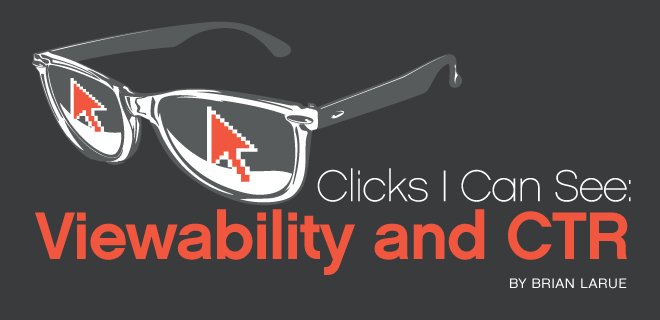
Brand advertisers and agencies have decided viewability is their chosen cause this year — and why not? The point of serving ads is for those ads to be seen. If no one sees the ad, why should the advertiser be obliged to pay for it?
Well, the complicated part is that, industry-wide, we’re demanding viewability in digital, but by and large, we’re still evaluating campaign performance using click-throughs. There may be a correlation between viewability and clicks, but the two don’t always work in harmony with each other. They certainly don’t operate by the same conventional wisdom.
Publishers can be empowered by understanding how viewabilty and CTR work and don’t work together: By explaining the nuances to advertisers, pubs can give those advertisers a deeper understanding of campaign performance, can help advertisers get more bang for their buck, and ultimately can help foster longer-term business relationships between pubs and buyers.
We do have some agreement on what viewability means, except for when we don’t. By the IAB’s standards, a display ad is viewable when at least 50% of its pixels are in view for one second. Add an extra second for video. Custom ad units are an exception, as is mobile — neither have clear standards in place just yet.
When we talk about viewability, the phrase “above-the-fold” comes up so frequently, an outsider might think it’s a proxy or a synonym for viewability, but it’s not. It’s certainly not a proxy for clicks. If a banner takes too long to load, there’s the chance the user will never see it — they’ve already scrolled down to the content they came for. An ad at the bottom of the page — in view when the user has switched mindsets and is no longer ravenously plowing through content — might actually get more clicks than an ad at the top (especially if the ad at the top loads slowly).
The meaty part for publishers, though, is the point where viewability and CTR intersect and determine CPMs. The advertiser gauges a campaign’s performance by CTR. When it determines CTR, it’s not separating viewable impressions from non-viewable impressions — it’s calculating all impressions served.
A campaign may very well perform at or beyond the advertiser’s expectations when it comes to viewable ads only. But that performance would look pretty poor if enough impressions were not viewable. Say you’re a publisher and 40% of your impressions aren’t viewable. It doesn’t matter how well your other 60% is performing: The other 40% is making you look bad, it’s cutting into your CTR (the average clicks over all your impressions, viewable and not), and it’s driving down the overall value of your inventory.
Phil Gale, Director of Publisher Development for the U.K. cross-screen branding platform Phunware, reached out to AdMonsters a few days ago to talk about how CTR plays into publishers’ ability to re-book. He offered an example of how a competitive “true CTR” — performance across impressions that are actually viewable — can look weaker to a paying advertiser, when a publisher’s overall viewability rates are lower than its competitors.
Imagine, Gale says, two publishers, each partnering with the same brand on the same campaign. Publisher A runs the campaign at 85% average viewability, and Publisher B at 55%. That’s an average viewability rate taking into account all placements on all devices. Initially, both publishers hit a 0.7% CTR for mobile banner ads that are viewable to the user. But the advertiser is calculating CTR from all served impressions during the campaign, lumping non-viewable impressions in with viewable impressions.
By those metrics, Gale explained, the advertiser clocks Publisher A’s CTR at 0.6% and Publisher B’s at 0.39%, and to optimize the campaign, it halts its buys on Publisher B and shifts that remaining budget over to Publisher A. “In this example, Publisher B could argue that its CPM is 30% lower than Publisher A’s,” Gale says. “But this would not necessarily be considered, given that the performance indicator is CTR, not eCPC.”
It gets complicated, Gale elaborated, when you have vendors, who themselves don’t have a consistent methodology for determining viewability, speaking to advertisers on behalf of publishers and their inventory. “They might say, ‘We give 100% viewability,’ which is what advertisers want to hear,” he says, but the vendor might not make clear upfront how much of the publisher’s inventory they’re going to sell in order to keep its own viewability numbers high.
Factor in the question of which inventory is being transacted upon via which vendor, and you end up with a lot of required oversight and due diligence for the publisher working with 10 vendors simultaneously.
It may seem it’s in the best interest of publishers to push for measuring only on viewed impressions, except for a couple things. One, advertisers have been pretty clear they don’t want to do that. Two, publishers would see the volume of impressions on their end drop in the short run.
“They’d lose 20% of impressions overnight,” Gale predicts, “but they can raise CPMs by 20%.”
The exact numbers will certainly vary for publishers, and we can debate the relative fairness of changing up advertisers’ long-standing metrics for campaign performance. Regardless, publishers need to take a look at the disparity between their current CPMs, and the reality of what their inventory should be worth. Where does viewability play a role? How can pubs communicate this to advertisers and vendor partners? And what’s it worth to pubs to change the way they do business accordingly?